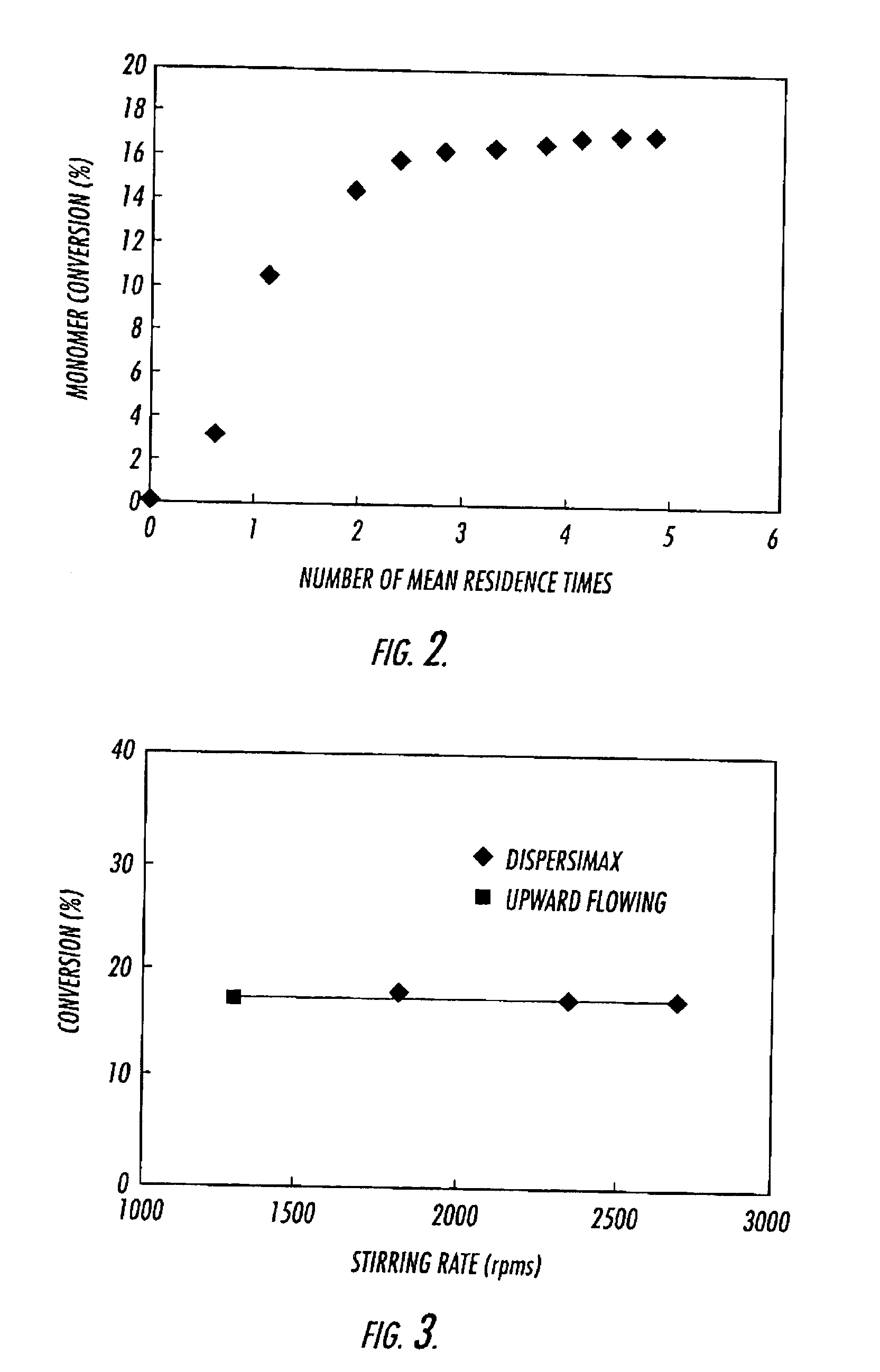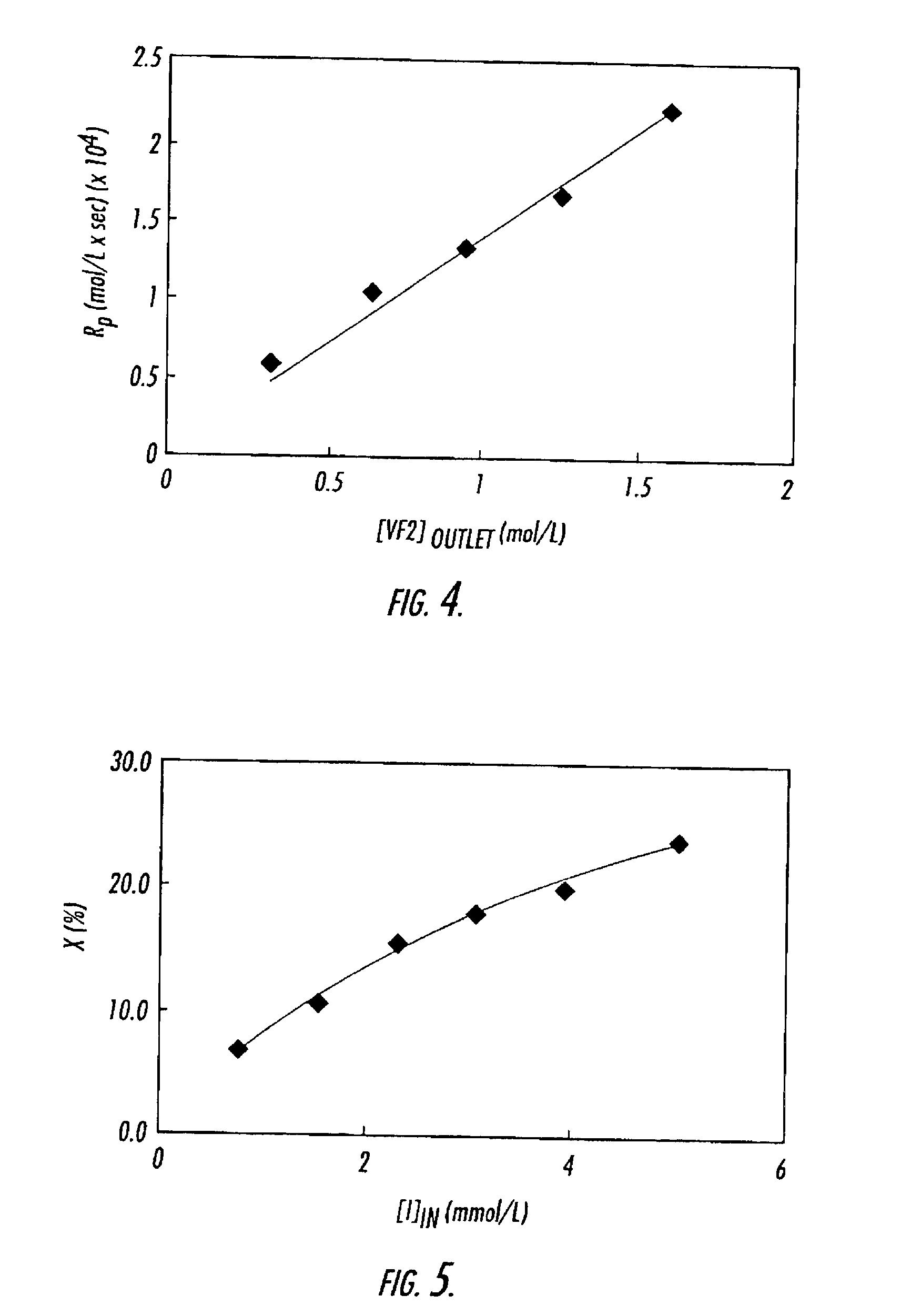Continuous process for making polymers in carbon dioxide
a technology of carbon dioxide and reaction medium, which is applied in the direction of supercritical condition processes, bulk chemical production, pressurized chemical processes, etc., can solve the problems of large reactors which are costly at the high pressure of scco/sub, the difficulty of recycling co/sub>2 /sub> and the unreacted monomer, and achieves the facilitation of monomer and supercritical fluid recycling, small equipment, and cheaper
- Summary
- Abstract
- Description
- Claims
- Application Information
AI Technical Summary
Benefits of technology
Problems solved by technology
Method used
Image
Examples
example 1
Chain-Growth Precipitation Polymerizations
[0077]The experimental system consists of an intensely mixed, continuous stirred tank reactor (CSTR), followed by two high-pressure filters in parallel, where the polymer is collected. This method is widely applicable to various monomers in heterogeneous polymerizations, both with and without surfactants. Herein we report on our experiments with vinylidene fluoride (VF2) performed at a temperature of 75° C., a pressure of 275 bar, and at residence times from 15 to 50 minutes. The poly(vinylidene fluoride) polymer (PVDF) was collected as a dry “free-flowing” powder, and has been characterized by gel permeation chromatography (GPC).
[0078]Materials. VF2 monomer was donated by Solvay Research, Belgium and SFE / SFC grade CO2 was donated by Air Products & Chemicals, Inc. All other chemicals were obtained from Aldrich Chemical Company.
[0079]Initiator Synthesis. The DEPDC (diethylperoxydicarbonate) initiator was synthesized as previously reported, us...
example 2
Continuous Precipitation Polymerization of Vinylidene Fluoride in Supercritical Carbon Dioxide: Comparison of Experimental to Model Rp
[0089]This example describes the heterogeneous polymerization of vinylidene fluoride. Poly(vinylidene fluoride) (PVDF) is a semicrystalline polymer and is produced commercially by either emulsion or suspension batch techniques at polymerization conditions of between 10-200 bar at temperatures from 10-130° C. (Dohany, J. E. and J. S. Humphrey, Vinylidene Fluoride Polymers, in Encyclopedia of Polymer Science and Engineering, H. F. Mark, et al., Editors. 1989, Wiley: New York. p. 532-548; Russo, S., M. Pianca, and G. Moggi, Poly(vinylidene fluoride), in Polymeric Materials Encyclopedia, J. C. Salamone, Editor. 1996, CRC: Boca Raton. p. 7123-7127). The emulsion technique requires that the final polymer latex be first coagulated, thoroughly washed, then spray-dried before a free-flowing powder is obtained. The suspension technique requires separation of t...
example 3
Large-Scale Apparatus
[0119]One embodiment of a scaled-up apparatus for implementing the present invention is described in FIG. 12. Initiator is transported continuously to a reactor, along with, and at a separate location from, carbon dioxide and monomer, which are introduced via a recirculation line through a recirculation pump. Make-up CO2 and monomer may be introduced through the top of the reactor if so desired as depicted. Upon exiting the reactor, the effluent stream is cooled and is transported to a separator (e.g., a filter or cylcone configuration). Polymer product exits through the bottom of the reactor and is collected in the separator. Carbon dioxide, either through the top or bottom of the reactor, may be employed to assist with transporting the polymer to a low pressure bag filter or extruder hopper.
[0120]An effluent stream comprising carbon dioxide, unreacted monomer (if any), and unreacted initiator (if any) is recycled back to the reactor as shown in FIG. 12. A purg...
PUM
| Property | Measurement | Unit |
|---|---|---|
| pressure | aaaaa | aaaaa |
| pressure | aaaaa | aaaaa |
| pressure | aaaaa | aaaaa |
Abstract
Description
Claims
Application Information
 Login to View More
Login to View More - R&D
- Intellectual Property
- Life Sciences
- Materials
- Tech Scout
- Unparalleled Data Quality
- Higher Quality Content
- 60% Fewer Hallucinations
Browse by: Latest US Patents, China's latest patents, Technical Efficacy Thesaurus, Application Domain, Technology Topic, Popular Technical Reports.
© 2025 PatSnap. All rights reserved.Legal|Privacy policy|Modern Slavery Act Transparency Statement|Sitemap|About US| Contact US: help@patsnap.com



